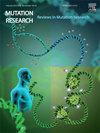WTAP-mediated m6A modification of ARG2 mRNA Inhibits Its expression and drives prostate cancer malignant progression
IF 1.9
4区 医学
Q4 BIOTECHNOLOGY & APPLIED MICROBIOLOGY
Mutation Research-Fundamental and Molecular Mechanisms of Mutagenesis
Pub Date : 2025-07-01
DOI:10.1016/j.mrfmmm.2025.111912
引用次数: 0
Abstract
Background
Prostate cancer (PCa) incidence increases as age advances and seriously endangers men’s health worldwide. Arginase 2 (ARG2) has been identified as a potential diagnostic and prognostic marker for PCa. However, the molecular mechanisms underlying its function in PCa remain undefined.
Methods
ARG2 mRNA and protein expression were quantified in PCa tissues and cells using qRT-PCR and Western blot. Cellular proliferation, glucose consumption, lactate production, apoptosis, and ferroptosis were evaluated via EdU incorporation, colony formation assays, commercial kits, and flow cytometry. Subsequently, the xenograft model was established to assess ARG2’s role in tumor growth in vivo. Bioinformatics analysis and RNA immunoprecipitation (RIP) were employed to investigate the interaction between Wilms’ tumor 1-associating protein (WTAP), a key component of the N6-methyladenosine (m6A) methyltransferase complex, and ARG2 mRNA. Besides, mRNA stability was determined using actinomycin D chase assays.
Results
ARG2 exhibited low expression in PCa tissues and cells. Upregulation of ARG2 inhibited proliferation and glycolysis, and promoted apoptosis, oxidative stress and ferroptosis of PCa cells. However, silencing ARG2 had the opposite effects. In vivo, ARG2 overexpression suppressed tumor growth. Mechanistically, WTAP bound directly to ARG2 mRNA, and their expression levels were inversely correlated. WTAP knockdown phenocopied ARG2 overexpression by repressing proliferation and glycolysis and enhancing apoptosis/ferroptosis, effects reversed by ARG2 silencing. ARG2 overexpression counteracted the oncogenic effects of WTAP overexpression.
Conclusion
WTAP bound to ARG2 and suppressed its expression, thereby promoting the malignant progression of PCa.
wtap介导的m6A修饰ARG2 mRNA抑制其表达并驱动前列腺癌恶性进展
前列腺癌(PCa)的发病率随着年龄的增长而增加,严重危害着全球男性的健康。精氨酸酶2 (ARG2)已被确定为前列腺癌的潜在诊断和预后标志物。然而,其在前列腺癌中作用的分子机制仍不明确。方法采用qRT-PCR和Western blot方法检测前列腺癌组织和细胞中sarg2 mRNA和蛋白的表达。细胞增殖、葡萄糖消耗、乳酸生成、凋亡和铁下垂通过EdU并入、菌落形成测定、商业试剂盒和流式细胞术进行评估。随后,我们建立了异种移植物模型来评估ARG2在体内肿瘤生长中的作用。采用生物信息学分析和RNA免疫沉淀(RIP)技术研究了n6 -甲基腺苷(m6A)甲基转移酶复合物的关键组分Wilms ' tumor 1- associated protein (WTAP)与ARG2 mRNA的相互作用。此外,利用放线菌素D追逐法测定mRNA的稳定性。结果sarg2在前列腺癌组织和细胞中低表达。ARG2的上调抑制了PCa细胞的增殖和糖酵解,促进了细胞凋亡、氧化应激和铁下垂。然而,沉默ARG2具有相反的效果。在体内,ARG2过表达抑制肿瘤生长。在机制上,WTAP直接与arg2mrna结合,两者的表达水平呈负相关。WTAP通过抑制增殖和糖酵解以及增强细胞凋亡/铁下垂来抑制表型ARG2的过表达,而这种作用被ARG2沉默逆转。ARG2过表达抵消了WTAP过表达的致癌作用。结论wtap与ARG2结合,抑制其表达,从而促进前列腺癌的恶性进展。
本文章由计算机程序翻译,如有差异,请以英文原文为准。
求助全文
约1分钟内获得全文
求助全文
来源期刊
CiteScore
4.90
自引率
0.00%
发文量
24
审稿时长
51 days
期刊介绍:
Mutation Research (MR) provides a platform for publishing all aspects of DNA mutations and epimutations, from basic evolutionary aspects to translational applications in genetic and epigenetic diagnostics and therapy. Mutations are defined as all possible alterations in DNA sequence and sequence organization, from point mutations to genome structural variation, chromosomal aberrations and aneuploidy. Epimutations are defined as alterations in the epigenome, i.e., changes in DNA methylation, histone modification and small regulatory RNAs.
MR publishes articles in the following areas:
Of special interest are basic mechanisms through which DNA damage and mutations impact development and differentiation, stem cell biology and cell fate in general, including various forms of cell death and cellular senescence.
The study of genome instability in human molecular epidemiology and in relation to complex phenotypes, such as human disease, is considered a growing area of importance.
Mechanisms of (epi)mutation induction, for example, during DNA repair, replication or recombination; novel methods of (epi)mutation detection, with a focus on ultra-high-throughput sequencing.
Landscape of somatic mutations and epimutations in cancer and aging.
Role of de novo mutations in human disease and aging; mutations in population genomics.
Interactions between mutations and epimutations.
The role of epimutations in chromatin structure and function.
Mitochondrial DNA mutations and their consequences in terms of human disease and aging.
Novel ways to generate mutations and epimutations in cell lines and animal models.

 求助内容:
求助内容: 应助结果提醒方式:
应助结果提醒方式:


